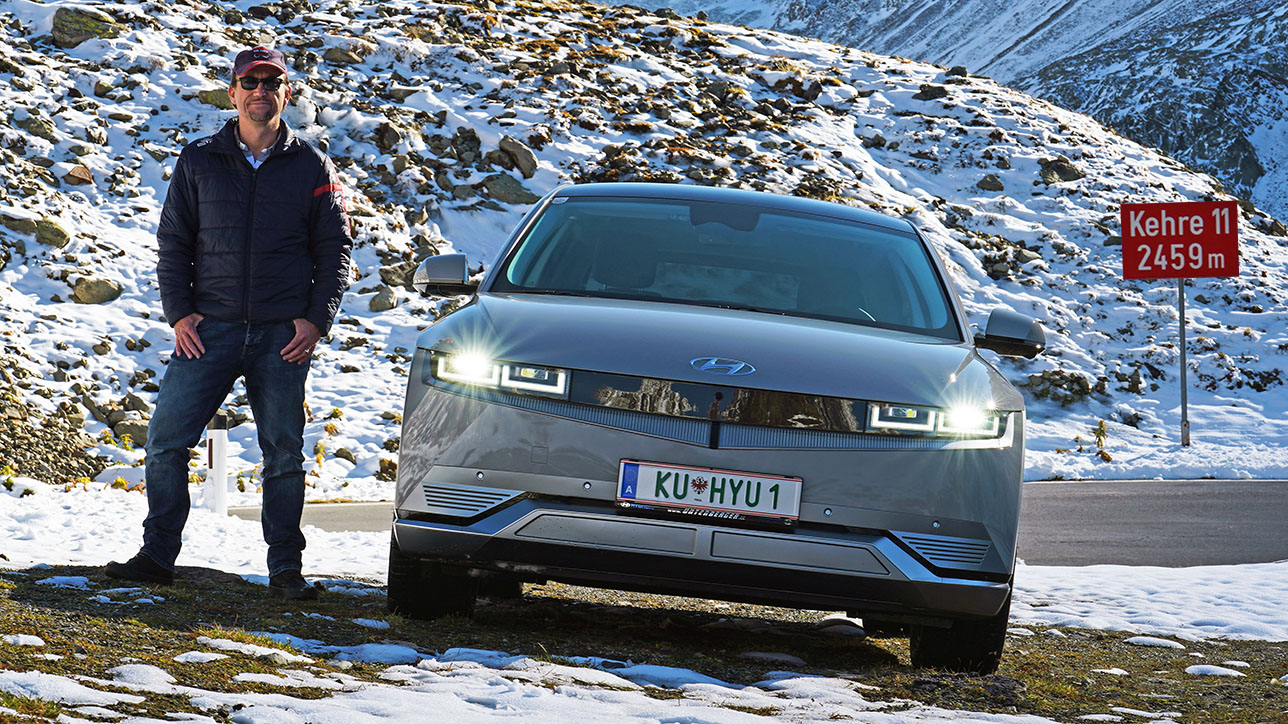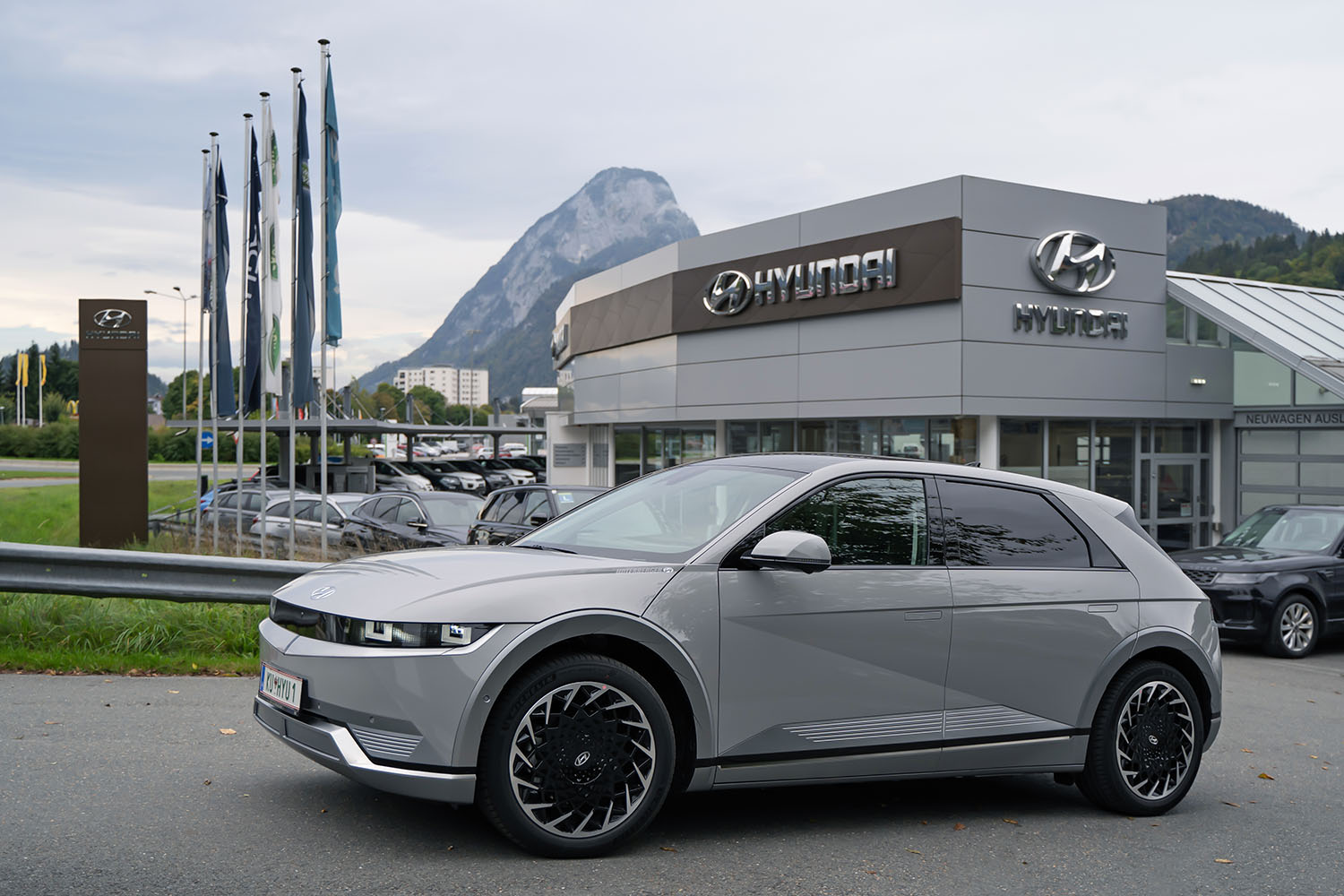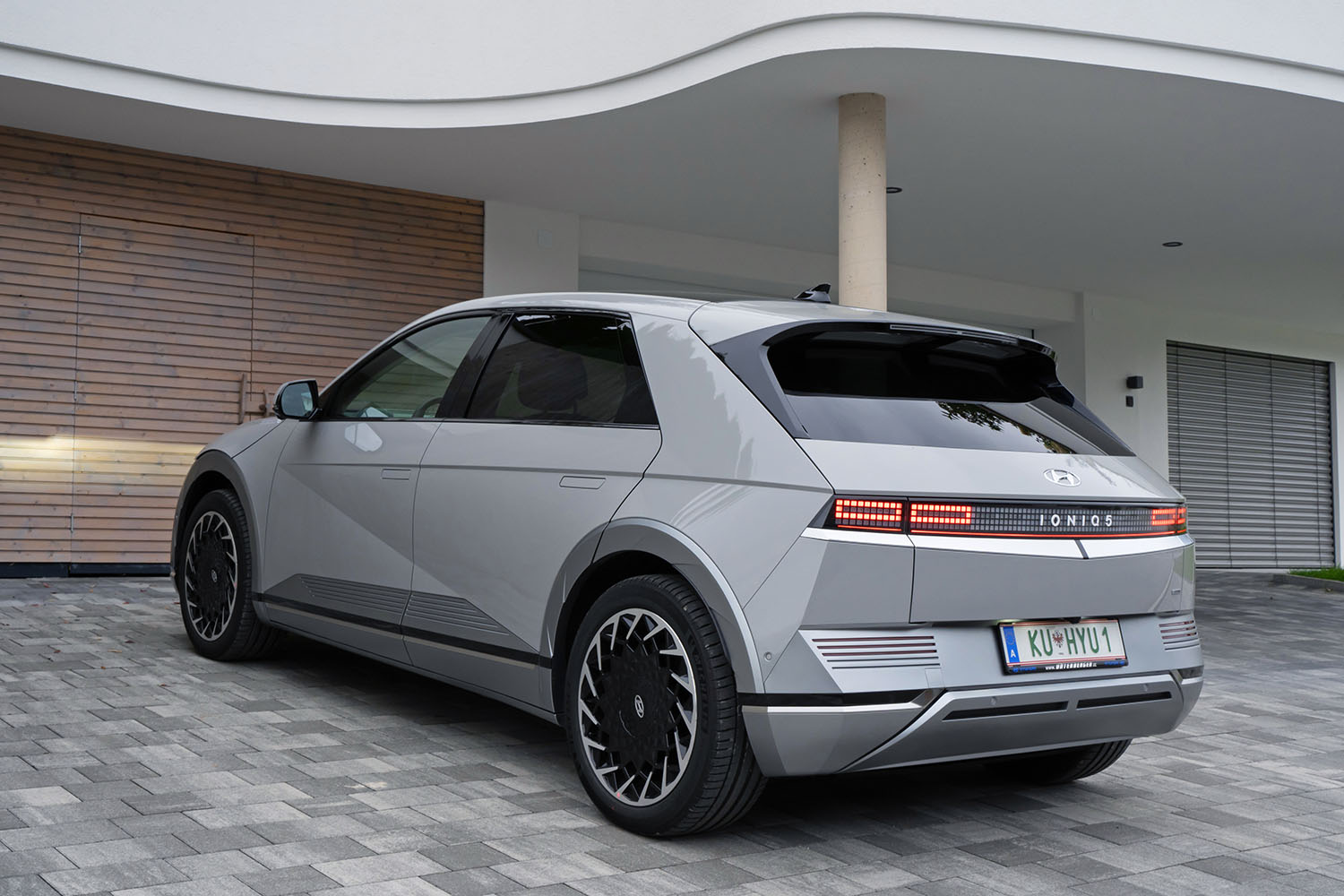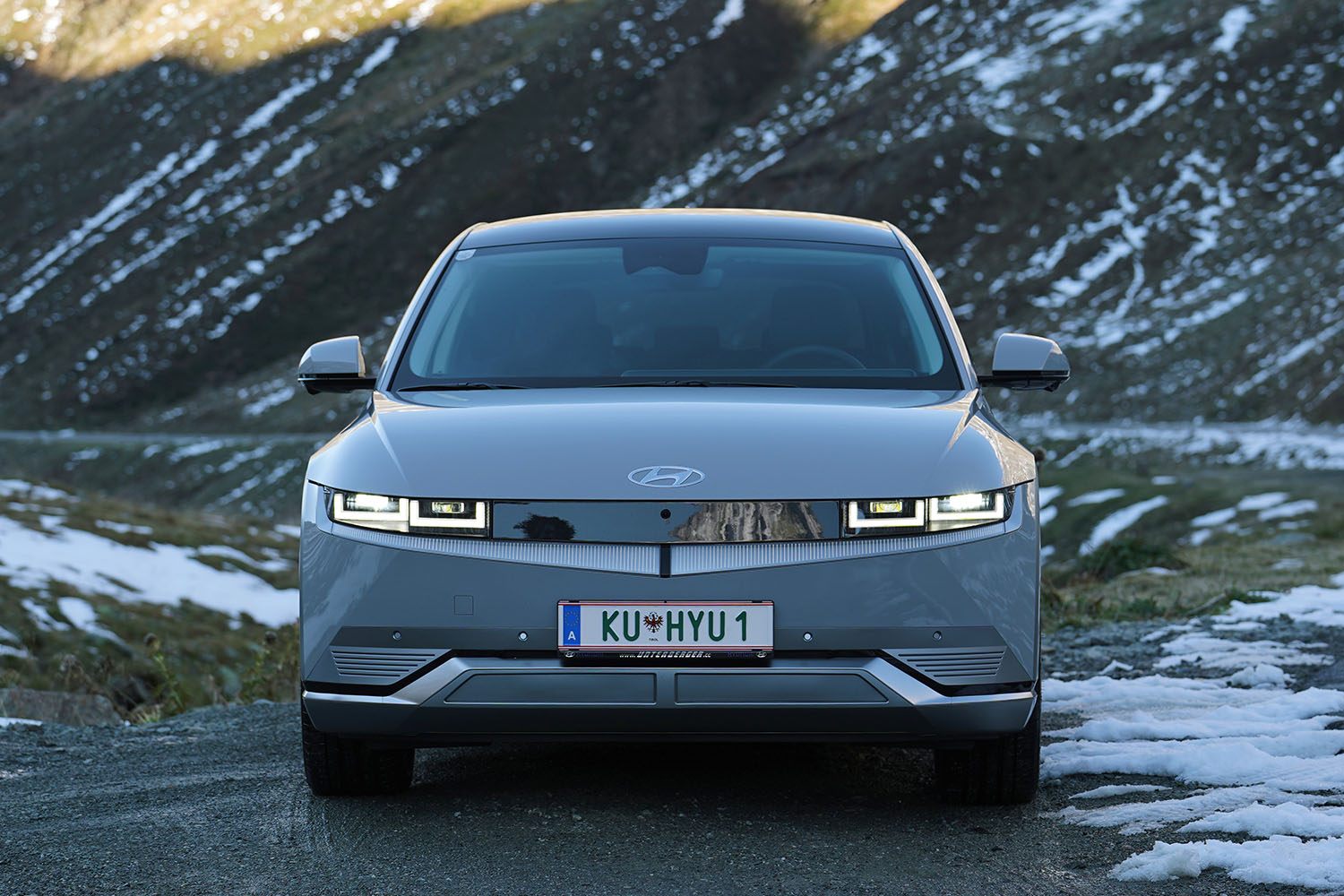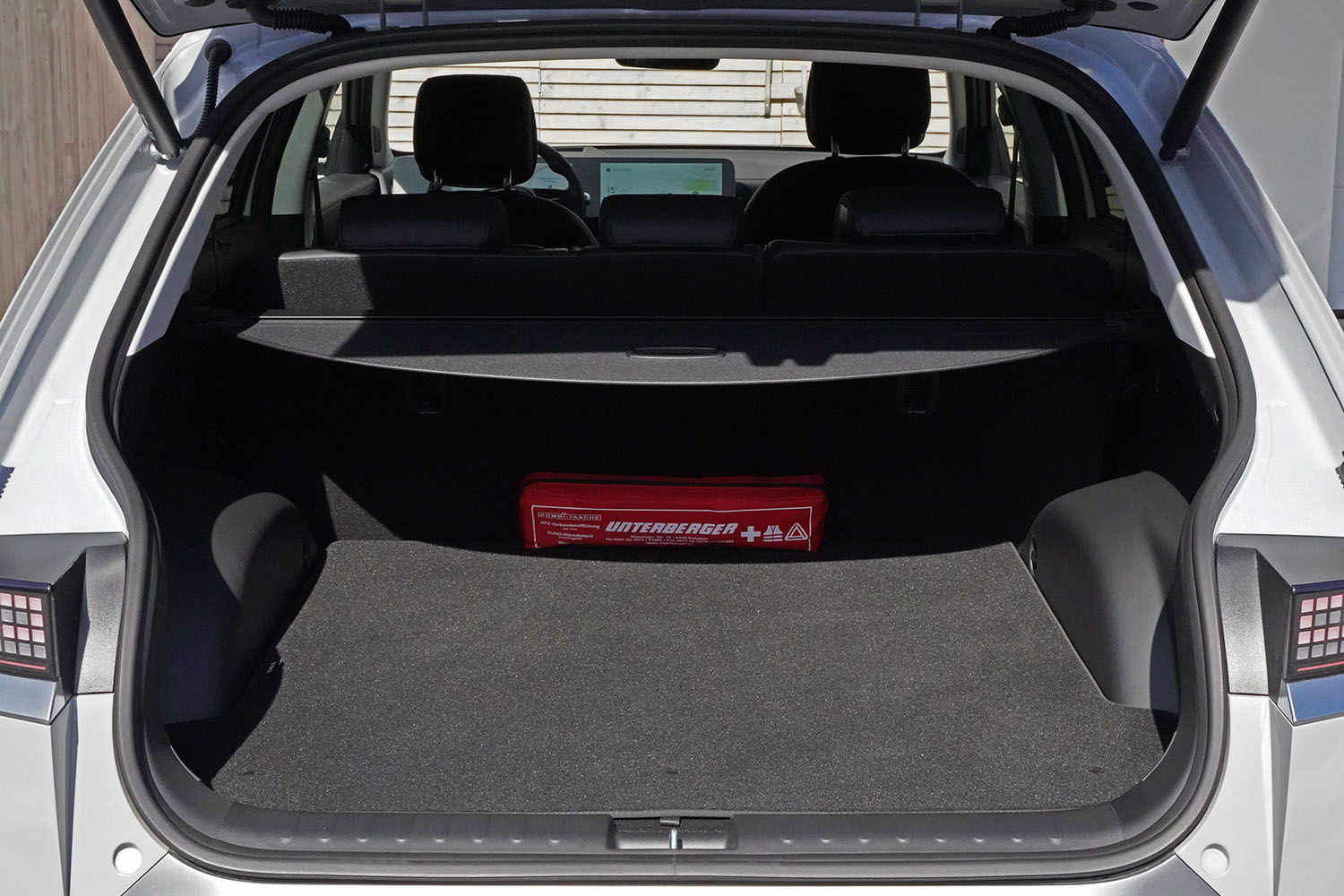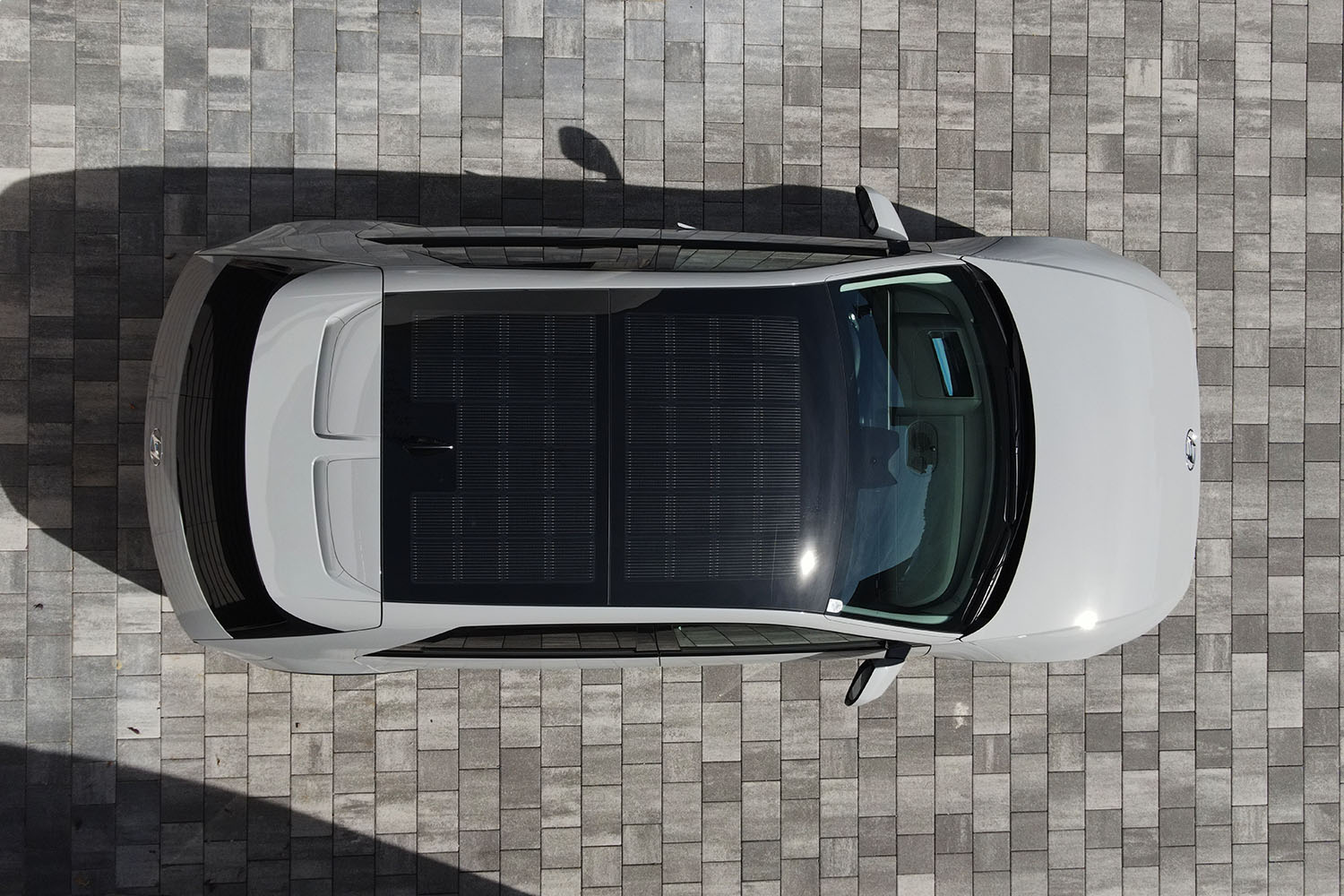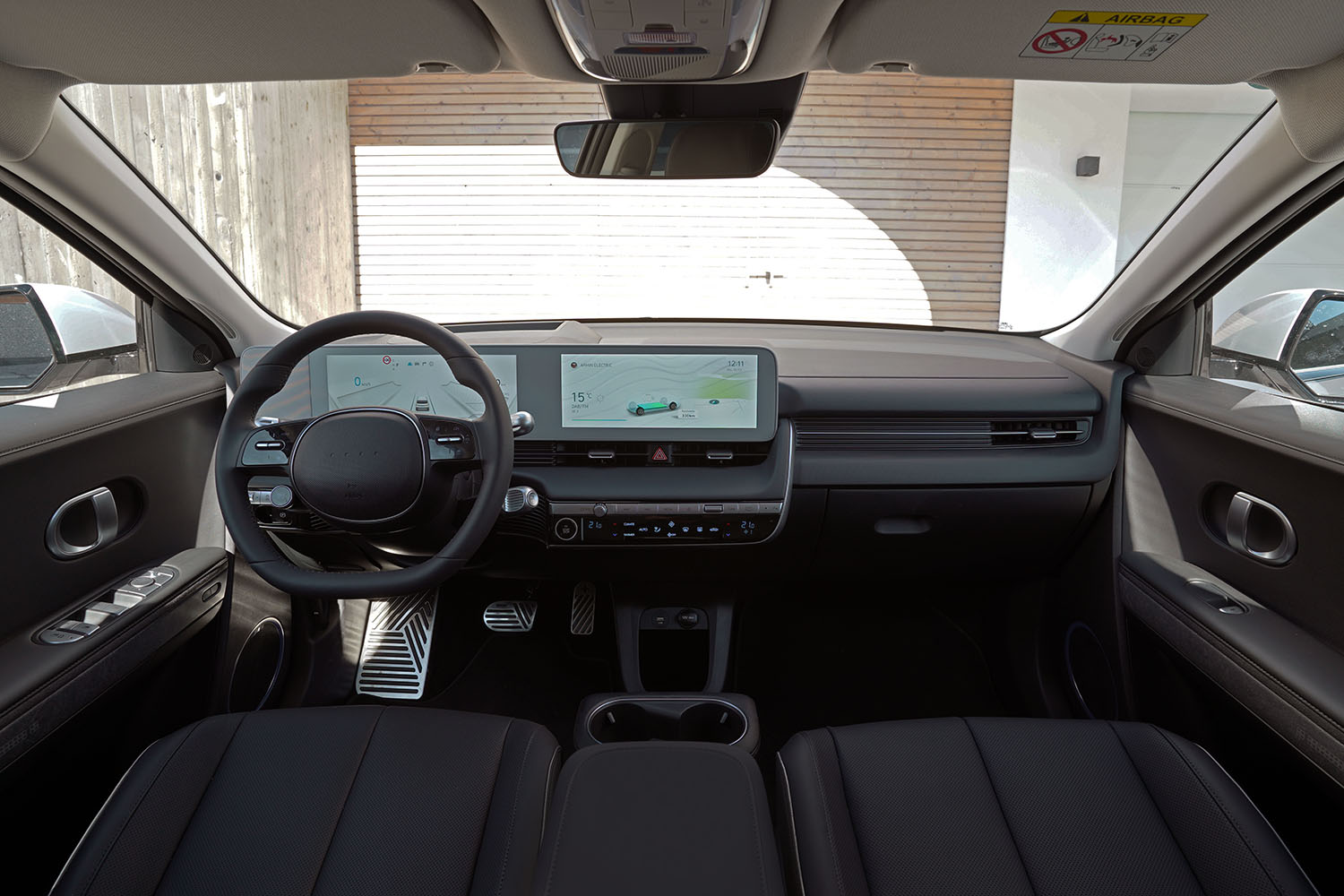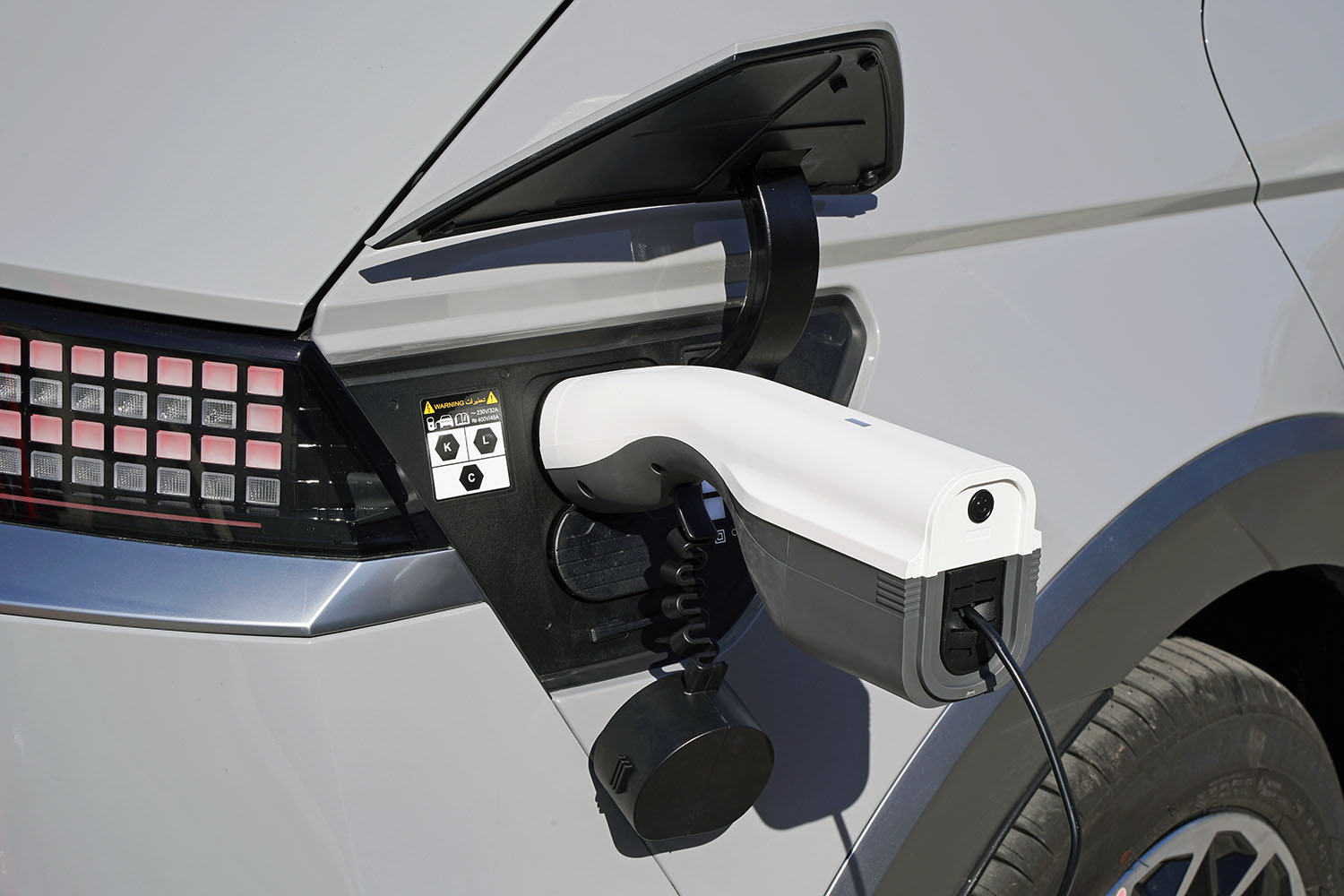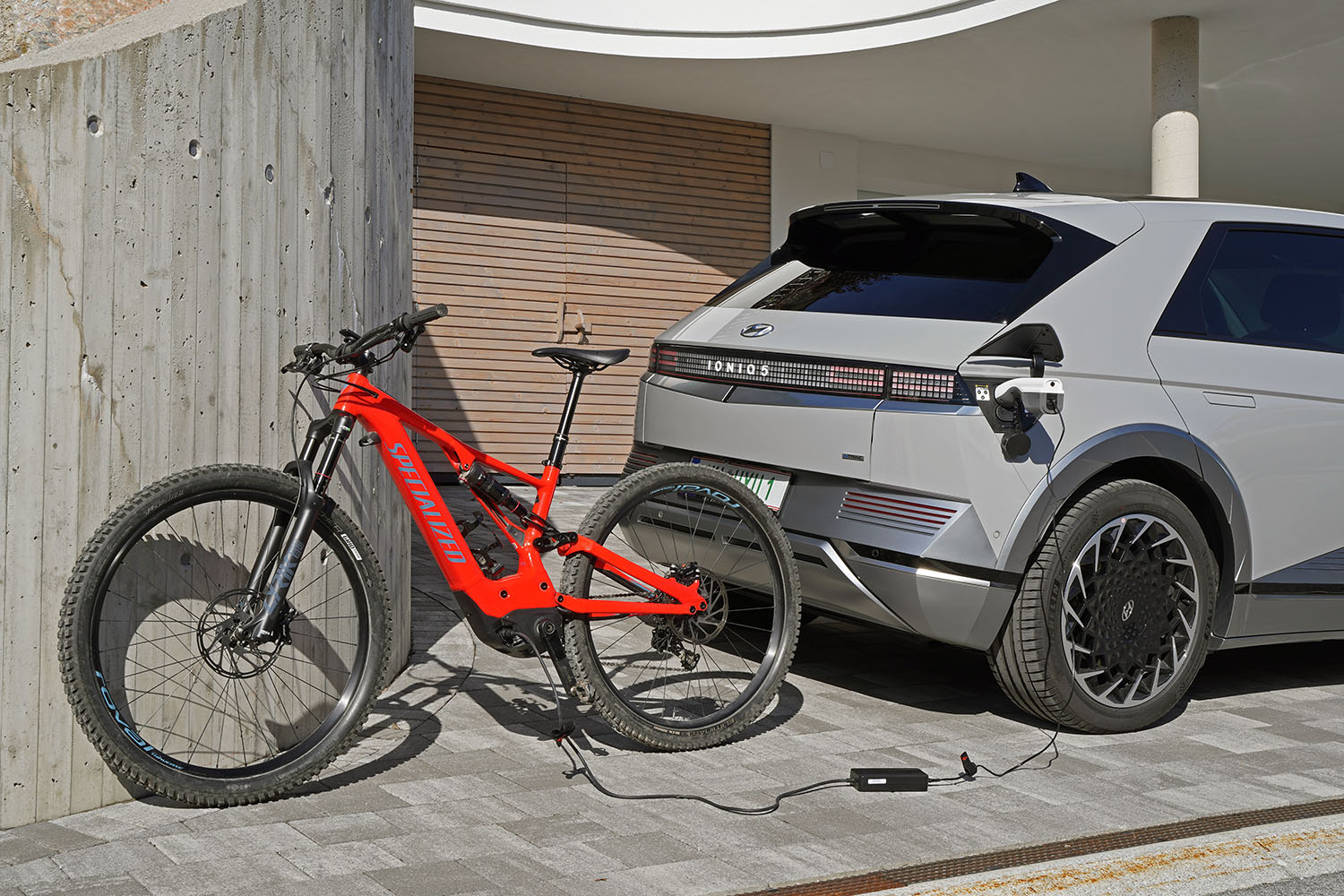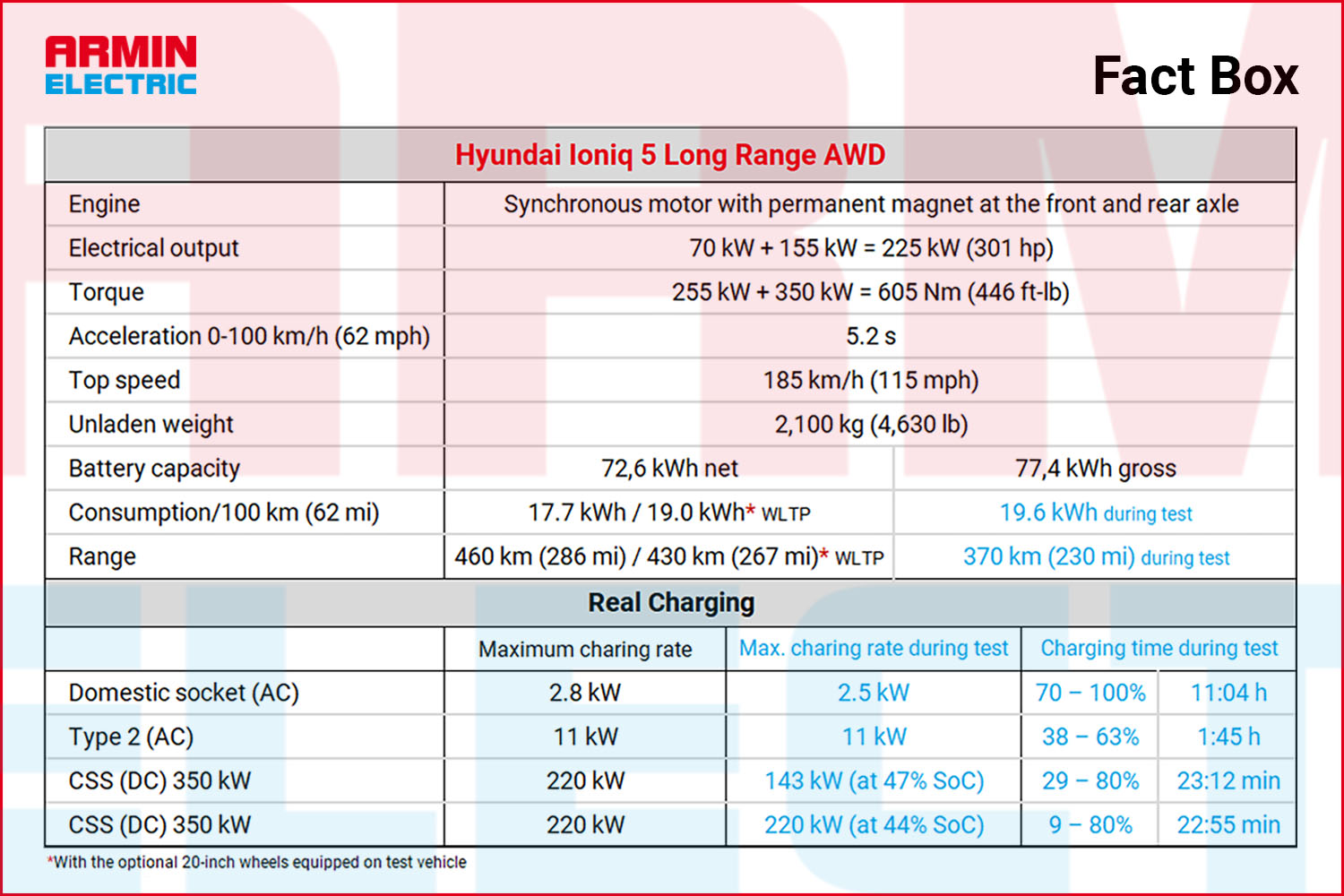Merano | South Tyrol, Italy – With the Ioniq 5, Hyundai has ushered in a new era for its all-electric vehicles by creating a forward-thinking design that runs on a new, specially developed platform. I was lucky enough to test the electric vehicle for you over several alpine passes…
The retailer Unterberger Automobile is part of the Kufstein-based Unterberger Group. Founded in 1976, it now offers vehicles from eleven brands, including the latest electric cars, at 19 locations in western Austria and neighbouring southern Germany. The Kufstein Autowelt branch provided me with the all-electric Hyundai Ioniq 5 in the best possible “Top Line Long Range AWD” model for the test. This meant that the vehicle was fully equipped with the most extensive equipment package, the larger 72.6 kWh battery, 225 kW (305 hp) of power and all-wheel drive. The futuristic yet minimalist design with clean lines and pixel LED lighting immediately caught my eye. Just looking at this EV, you’ll already feel as though you’ve travelled to the future of the automotive world. The name of the paint, “Galactic Grey,” and the colour itself perfectly fit the aesthetic.
FIRST STOP: MUNICH AIRPORT
Before I could start the journey across the Alps to Merano, my first stop was Munich, or more specifically, Munich Airport. It was a good opportunity to extensively test the motorway capabilities of the Ioniq 5. After charging the car at home with a home charger (2.5 kW charging power) from 85 to 100 percent SoC (State of Charge) in just under 4.5 hours, I set off early in the morning at a crisp outside temperature of 6˚ C (43˚ F). The temperature inside the car was a pleasant 21˚ (70˚ F), since I had already started the heating system on my smartphone before I left. I drove on the main road via Walchsee, crossing the German border and entering at Oberaudorf. I had already programmed the destination into the navigation system at home on the central 12-inch touchscreen. With the navigation-based cruise control activated, the vehicle automatically assumed the maximum speed. This function is available on motorways and expressways. When active, the “NAV” symbol in the driver’s display, which is also 12 inches, lights up green and displays the target speed.
A DIVERSITY OF MODELS
The Ioniq 5 is available in four power ratings, from a low of 125 kW (170 hp) to the test vehicle’s 225 kW (305 hp). The two most powerful versions are offered with all-wheel drive in addition to rear-wheel drive. For the battery, there is a choice between “Long Range” with 72.6 kWh and “Short Range” with 58.2 kWh net capacity. Equipped with the most powerful engine, the Ioniq 5 accelerates from zero to 100 km/h in an impressive 5.2 seconds. At 185 km/h (115 mph) (the speedometer read 190 km/h [118 mph] during the test), all versions are electronically limited. After 172 kilometres (107 mi) and a driving time of 2:07 hours, I reached Munich Airport with exactly 50 percent SoC and a predicted remaining range of 185 kilometres (115 mi). The average consumption was 20.4 kWh/100 km (62 mi) on the trip with a large share of motorways and short high-speed passages.
FAST CHARGING WITH DIFFICULTIES ON START-UP
The next evening, I drove back to Tyrol. The estimated remaining range might have been just enough to get me there. But since I was continuing on to Merano the next morning and only had a slow charging option at the socket at home, I wanted to arrive there with the battery as full as possible. So, I decided to charge at the 350 kW Ionity fast charging station of Holzkirchen Süd to test the potential of the 800 volt battery technology for the first time. The at times fast drive on the German Autobahn at an outside temperature of 11˚ C (52˚ F) had resulted in a consumption of 24.8 kWh/100 km (62 mi) after 70 kilometres. I tried to start the charge via the Ionity app, where I had entered my credit card as a means of payment during installation. Even though the payment was confirmed each time on the charging station screen, and therefore the charge seemed to be enabled, it would not work. After several unsuccessful attempts, I called the Ionity hotline.
That was how I learnt that there was currently a malfunction on the servers of the payment service during the payment authorisation and therefore the charging process had not been started. In a good gesture, the central office took care of this for me, and I was able to enjoy a free battery refill. (It’s worth mentioning that everything worked fine with the charging card in the car next door.) Hyundai promises a charging power of up to 220 kW for CCS DC charging. This was not achieved during the first fast charge of the new vehicle. With a maximum charge line of 143 kW, which only set in at 47 percent SoC, I charged the EV from 22 to 80 percent in 23:12 minutes. After a total of 47:05 minutes, 100 percent was reached. A very solid charging time compared to other EVs, but far from the 10 to 80 percent in 18 minutes that Hyundai boasts. After another 106 kilometres (66 mi), I arrived home in the Pillerseetal with 70 percent SoC. The average consumption for the 348-kilometre (216 mi) route to and from Munich Airport with 70 percent motorway was 21.7 kWh/100 km. Overnight, I was able to recharge the electric vehicle to 100 percent at the household socket in 11:03 hours. Remarkably, the estimated charging time of 11:10 hours was very accurate, as it was throughout the test.
SNOW ON TIMMELSJOCH
At the entrance to the Ötztal valley, we exited the motorway. For the previous 154 kilometres (96 mi) on the state motorways, the consumption was 18.1 kWh/100 km. From there, the winding Ötztal road climbs steadily in the direction of Sölden and then continues up in a few hairpin bends to the toll booth at the Timmelsjoch High Alpine Road, 2,171 metres above sea level. The part of the so-called “Top Mountain Crosspoint”, where the renowned Motorcycle Museum is located, was completely destroyed by fire this January. What’s more astonishing is that the reconstruction is already well underway and that the museum, which has been expanded to 4,500 m², will reopen its doors as early as this month. The panoramic road, which was completed in 1959 and has also served as a north-south link between Tyrol (Austria) and South Tyrol (Italy) since 1968, is used by just over 100,000 cars and 80,000 motorcycles every year.
After a short downhill, the road climbed again. At about 2,000 metres, we encountered the remnants of the snow that had fallen during the first brief onset of winter the week before. After 11 switchbacks, we had reached the Timmelsjoch at 2,474 metres (8117 ft) with an outside temperature of 4˚ C (39˚ F). This area is home to the deepest unglaciated valley of the main Alpine ridge between Reschen Pass and Brenner Pass. The battery level was 28 percent after driving 220 kilometres (137 mi), and the average consumption so far, to the highest altitude point of the trip, was 22.8 kWh/100 km, which was impressive considering the 1,770 metres (5807 ft) of altitude covered from Ötztal-Bahnhof. The predicted remaining range was 79 kilometres (49 mi), with 49 kilometres (30 mi) to go until our destination.
REGENERATION IN THE ALPINE PASS
The Ioniq 5 features a regenerative braking system that can feed energy back into the battery. The intensity is adjusted in three stages via shift paddles on the steering wheel. As soon as you release the accelerator pedal, the vehicle brakes to a greater or lesser extent and thus regenerates power. The second setting, right in the middle, felt the most comfortable to me during the test. With intelligent energy recovery, an additional setting is available in which the regenerative braking effect automatically adjusts to the driving conditions.
By driving with foresight and using the conventional braking system as little as possible, I was able to recover six percent battery charge on the winding route with numerous switchbacks down to St. Leonhard in Passeier at 689 metres (2260 ft) above sea level. This meant that 36 percent SoC was back on board as we continued to Merano. We reached our destination for the day with a low average consumption of 16.6 kWh/100 km. It should be taken into account that our starting point was at 850 metres (2789 ft) and the destination was at 325 metres (1066 ft) above sea level. Charging stations are displayed in the Ioniq 5. However, I would have liked an option to schedule a charge, which would allow the car to calculate what battery level it will reach its destination with.
A COMFORTABLE AND SUSTAINABLE INTERIOR
When designing the interior, Hyundai aimed to give it the character of a comfortable living space. For example, the entire centre console, which has large, practical storage space, can be moved by 140 millimetres to provide more freedom of movement when needed. The electronically adjustable front seats can be folded down at the touch of a button and transformed into comfortable recliners with leg rests. Sadly, I wasn’t able to relax and watch the sky through the panorama roof during a break. This was left out of the design in favour of the solar roof, which supplied 1.3 kWh to the battery over six partly cloudy days in the test. The rear seats can be electronically moved forward by up to 135 millimetres to increase the load volume of the trunk, which holds 527 litres and can be expanded to 1,587 litres by folding down the rear seat bench. Under the hood is an additional storage space (frunk) with a capacity of up to 57 litres (2WD).
Sustainability was the central idea in building this vehicle. The car’s interior sports textiles and fabrics sourced from a wide variety of environmentally friendly raw materials. Fibres ranging from sugar cane biocomponents to recycled PET plastic bottles are used. Most of the surfaces are coated with a polyurethane organic lacquer made from natural oils, showing that drive technology is not the only way in which the Ioniq 5 thinks environmentally.
HYUNDAI’S FORAY INTO THE E-GMP PLATFORM
With the Ioniq 5, Hyundai has launched its first electric car with a platform developed specifically for all-electric vehicles. As I experienced first-hand in the test, the new Electric-Global Modular Platform (E-GMP) helps improve roadholding and driving stability. Low-lying battery packs and optimum weight distribution between the front and rear axles help to improve the car’s stability. The long wheelbase of three metres, short overhangs and slim cockpit module maximise the size of the interior, creating a new sense of space. The flat floor in the interior further enhances the space. For improved safety, the battery packs are supported by a structure of strong steel encased in embossed steel components. In the event of a collision, several energy-absorbing sections in the body take the burden of the impact shock.
ADVANCED DRIVING ASSISTANCE SYSTEMS
A comprehensive array of driving assistance systems contributes to the Ioniq 5’s safety features. This starts as soon as the driver pulls away, with numerous parking assistance functions through to remote-controlled parking and unparking. A 360-degree camera system shows the entire vehicle and its surroundings from above (or from other desired perspectives). While driving, adaptive cruise control keeps a constant set distance to the vehicle in front. Lane-following and lane-keeping assist ensure that the vehicle remains in its lane. A variety of functions helps avoid collisions in a wide range of driving situations. The blind spot assist alerts the driver both visually and audibly. When the turn signal is activated, the camera also shows the rear view on the driver’s display. Emergency Brake Assist detects pedestrians, cyclists and vehicles, reducing the chance of collisions. The exit assistant ensures safe exiting of the car. This function warns if opening a door will endanger an oncoming car, and if so, it also prevents the child safety lock from turning off.
THE E-CAR THAT CHARGES YOUR E-BIKE
The “Vehicle to Load” or “V2L” function makes it possible to charge or use other electric vehicles or devices on the Ioniq 5’s battery. V2L can deliver up to 3.6 kW of charging power. For my electric bike, it delivered the necessary 0.2 kW (42 V, 4.0 amps) specified on the bike’s charger. I connected my bike to the car using a converter for 230 V plugs, which can be ordered as an optional extra and is plugged into the charging port. This supplies power when the vehicle is not in operation. However, the socket under the rear seat can be used even when the vehicle is in operation.
AC CHARGING AFTER A FAST-CHARGING MALFUNCTION
After a bit of research, I realized there is only one fast charging station with over 100 kW in Merano: the 150 kW Hypercharger operated by Neogy at the central station. The energy provider, based in Bolzano, offers several ways to use its charging infrastructure. In addition to their pay-per-usage subscription, there is a prepaid card, meant for temporary stays in South Tyrol. Either way, you can use the Neogy Mobility app, which provides useful information, such as the locations of charging stations, charge history and charge curves. Since neither was available to me this time, I scanned the QR code of the charging station with my smartphone as usual to start the charging process on the Neogy website using PayPal (0.75 euros/kWh). It started off smoothly. CCS charging started at 29 percent state of charge. According to the onboard electronics, 80 percent should be reached in 23 minutes. Soon after, something went wrong: at 38 percent, charging suddenly stopped. Another attempt ended after 42 seconds, after which I could no longer start the charging process on the web platform. A call to the German-language hotline revealed that the internal system was also reporting a problem with the charging station. The reason for this could not be given, and the inquiry at Neogy’s headquarters remained unanswered by the editorial deadline.
Since the 38 percent SoC didn’t seem sufficient to comfortably get over Jaufen Pass and Brenner Pass, I switched to the Neogy Type 2 charging station with 22 kW, which was right next door. There, everything worked perfectly. After plugging in the three-phase charging cable provided by the car and starting the charging process as usual (0.47 euros/kWh), I was able to charge 19.5 kWh in 1:45 hours and thus reach a charge level of 63 percent. According to the on-board display, it would have taken a total of 3:30 hours to fully charge.
MAXIMUM CHARGING POWER ON THE SECOND TRY
The journey back home from Merano took us via St. Leonhard in Passeier through numerous switchbacks and hairpin bends up to Jaufen Pass (Passo di Monte Giovo) at an altitude of 2,094 metres (6870 ft). It is the northernmost Alpine pass in Italy and connects the Passeier Valley with the Wipp Valley, which we reached via Sterzing after even more hairpin bends. At Brenner Pass, the battery charge was still 32 percent, so I decided to continue on to the IONITY fast-charging station in Angath Nord without stopping to charge. We had completed the 191 kilometres (117 mi) from Merano over two mountain passes with an average consumption of 18.8 kWh/100 km. Using the IONITY app, I was able to conveniently start the charge at 9 percent SoC. Only after 15 minutes was the maximum possible charging power of 220 kW reached at 44 percent. After a continuous drop, it landed finally at 97 kW in the end. In 22:55 minutes, 53 kWh were charged at a price of 0.79 euros/kWh and the battery was 80 percent full.
I contacted Hyundai Austria to inquire about this unusual charging behaviour, as it took a long time to reach the maximum charging power. According to information provided by Hyundai Motor Europe, this was most likely due to the high temperature of the traction battery at the start of charging. This would occur if the vehicle was driven on fast motorways or expressways immediately before charging, as it was during the test. In this case, the battery would have to be cooled down by the cooling agent in the first charging phase to achieve optimum charging performance. In order to fully understand why the car charged slowly this time, I would have needed temperature data for the battery and the charging station, which was not available to me.
ARMIN ELECTRIC CONCLUSION
With the Ioniq 5, Hyundai has created an electric vehicle that will leave no one underwhelmed. The futuristic design makes the CUV (Crossover Utility Vehicle) truly eye-catching. The handling is intuitive, and the top version offers every convenience imaginable. The only missing feature is charge scheduling, which is already standard in electric vehicles of this class.
The average consumption of 19.6 kWh/100 km on the 1,044 test kilometres (649 mi), including a significant motorway portion and two mountain passes over 2,000 metres (6562 ft), was very good. This was despite the more fuel-intensive 20-inch wheels and outside temperatures of 12˚ C (54˚ F) maximum. With the larger of the two available batteries (72.6 kW net capacity), this resulted in a very practical range of 370 kilometres (230 mi). The 800-volt battery technology is unique in this vehicle class with a possible charging power of an impressive 220 kW. Still, it is a shame that the maximum charging power is delayed after a longer drive on the motorway, as ultrafast charging would be ideal for just that kind of driving. Considering that this spares the battery in the long run, though, a few “lost” minutes are excusable.
The Hyundai Ioniq 5 starts at 39,990 euros in Austria (£36,995 in the UK). The test vehicle, which included all the available optional equipment, marked the upper end of the price scale at 62,700 euros (with 2,400 euros for the manufacturer’s share of the E-Mobility Promotion Package already deducted from the price). From the affordable entry-level model to the comprehensive, sporty top model, this EV is sure to be a crowd-pleaser and a success for Hyundai. The Ioniq 5 will also be launched in the United States this winter (more info here…).
Text and photos: Armin Hoyer – arminelectric.com
Cover photo: Dagmar Berger
Translation from German: Ethan Shenhar

